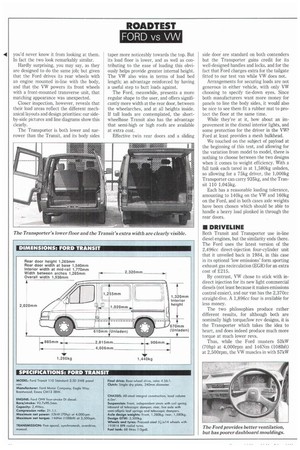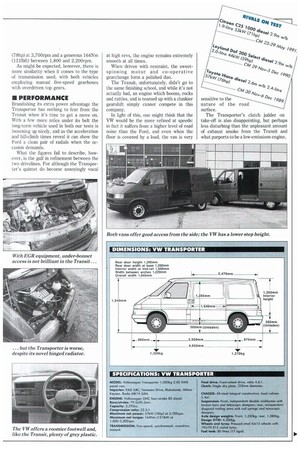ROADT EST FORD vs VW
Page 32

Page 33

If you've noticed an error in this article please click here to report it so we can fix it.
you'd never know it from looking at them. In fact the two look remarkably similar.
Hardly surprising, you may say, as they are designed to do the same job; but given that the Ford drives its rear wheels with an engine mounted in-Line with the body, and that the VW powers its front wheels with a front-mounted transverse unit, that matching appearance was unexpected.
Closer inspection, however, reveals that their load areas reflect the different mechanical layouts and design priorities: our sideby-side pictures and line diagrams show this clearly.
The Transporter is both lower and narrower than the Transit, and its body sides taper more noticeably towards the top. But its load floor is lower, and as well as contributing to the ease of loading this obviously helps provide greater internal height. The VW also wins in terms of load bed length; an advantage reinforced by having a useful step to butt loads against.
The Ford, meanwhile, presents a more regular shape to the user, and offers significantly more width at the rear door, between the wheelarches, and at all heights inside. If tall loads are contemplated, the shortwheelbase Transit also has the advantage that semi-high or high roofs are available at extra cost.
Effective twin rear doors and a sliding side door are standard on both contenders but the Transporter gains credit for its well-designed handles and locks, and for the fact that Ford charges extra for the tailgate fitted to our test van while VW does not.
Arrangements for securing loads are not generous in either vehicle, with only VW choosing to specify tie-down eyes. Since both manufacturers want more money for panels to line the body sides, it would also be nice to see them fit a rubber mat to protect the floor at the same time.
While they're at it, how about an improvement in the dismal interior lights, and some protection for the driver in the VW? Ford at least provides a mesh bulkhead.
We touched on the subject of payload at the beginning of this test, and allowing for the variation from model to model, there is nothing to choose between the two designs when it comes to weight efficiency. With a full tank each tared in at 1,580kg unladen, so allowing for a 75kg driver, the 1,000kg Transporter can carry 935kg, and the Transit 110 1,045kg.
Each has a reasonable loading tolerance, amounting to 140kg on the VW and 160kg on the Ford, and in both cases axle weights have been chosen which should be able to handle a heavy load plonked in through the rear doors.
• DRIVELINE
Both Transit and Transporter use in-line diesel engines, but the similarity ends there. The Ford uses the latest version of the 2,496cc direct-injection four-cylinder unit that it unveiled back in 1984, in this case in its optional 'low emissions' form sporting exhaust gas recirculation (EGR) for an extra cost of £215.
By contrast, VW chose to stick with indirect injection for its new light commercial diesels (not least because it makes emissions control easier), and our van has the 2,370cc straight-five. A 1,896cc four is available for less money.
The two philosophies produce rather different results, for although both are nominally high torque/low rev designs, it is the Transporter which takes the idea to heart, and does indeed produce much more torque at much lower revs.
Thus, while the Ford musters 52kW (70hp) at 4,000rpm and 146Nm (1081bft) at 2,500rpm, the VW muscles in with 57kW (78hp) at 3,700rpm and a generous 164Nrn (1211bft) between 1,800 and 2,200rpm.
As might be expected, however, there is more similarity when it comes to the type of transmission used, with both vehicles employing manual five-speed gearboxes with overdriven top gears.
• PERFORMANCE Brandishing its extra power advantage the Transporter has nothing to fear from the Transit when it's time to get a move on. With a few more miles under its belt the long-term vehicle used in both our tests is loosening up nicely, and as the acceleration and hill-climb times reveal it can show the Ford a clean pair of radials when the occasion demands.
What the figures fail to describe, however, is the gulf in refinement between the two drivelines. For although the Transporter's quintet do become annoyingly vocal at high revs, the engine remains extremely smooth at all times, When driven with restraint, the sweetspinning motor and co-operative gearchange form a polished duo.
The Transit, unfortunately, didn't go to the same finishing school, and while it's not actually bad, an engine which booms, rocks and rattles, and is teamed up with a clunkier gearshift simply cannot compete in this company.
In light of this, one might think that the VW would be the more refined at speeds: in fact it suffers from a higher level of road noise than the Ford, and even when the floor is covered by a load, the van is very ...... sensitive to the .. .......... . L'ec nature of the road ...... ......... surface.
The Transporter's clutch judder on take-off is also disappointing, but perhaps less disturbing than the unpleasant amount of exhaust smoke from the Transit and what purports to be a low-emissions engine.




















































































